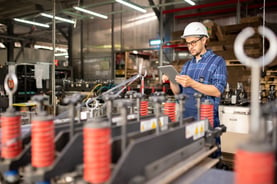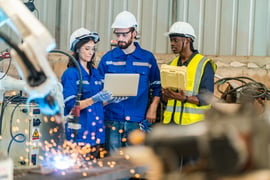Many employees in industrial manufacturing are given the same repetitive tasks day in and day out. This causes boredom and monotony, which can be draining. Plus, the likelihood of repetitive motion injuries is significant. One way to transform your operations is by integrating industrial robotics. These machines take on mundane tasks, giving businesses an advantage and easing the burden on staff, enabling them to focus on intricate or rewarding responsibilities. Sounds incredible, doesn't it? However, not every task benefits from an industrial robot. Let's review what suits industrial automation best and how to get started with industrial robotics.
Jump to a Section
Learning the Robotics Basics | Assessing Your Automation Readiness | Picking the Right Tasks for Automation | Financing Your Automation Journey | Avoiding Common Pitfalls | Integrating Collaborative Robots into Your Workflow | Inspecting the Road Ahead | Final Word: The Future is Now | FAQ & Resources
Ready to start your industrial automation journey? Watch our on-demand webinar and take the first step toward an automated and future-proof manufacturing operation.
Key Takeaways
|
Learning the Robotics Basics
Before you begin exploring robotic solutions, it's essential to lay a sturdy foundation of knowledge. Robotics is an intricate field, weaving together mechanics, electronics, and sometimes artificial intelligence (AI). Understand the various types of industrial robots, their applications, and how they integrate within an automated system.
🧾 Learn more about the basics of industrial robotics in our blog post What is Industrial Robotics?.
📺 Get more in-depth by watching our recorded webinar: Taking the leap into industrial robotics
Nomenclature and Varieties
After learning the basics, it's always a good idea to acquaint yourself with the jargon. From articulated arms to SCARA robots, each has a niche worth exploring. Familiarize yourself with the degrees of freedom, payload, and reach to align with your production line's needs.
Common Applications
Industrial robots' versatility is staggering. Explore applications such as material handling, welding, painting, assembly, and machine tending. Understanding the scope of robotic tasks is crucial for envisioning the enhancements they could bring to your manufacturing process. Check out some interesting applications below.
Safety and Regulations
Robotic safety standards are stringent for a reason. Review the requirements and standards like ISO 10218 and 13849 to ensure that your robotic deployment thrives and does so with a safety-first attitude.
Learn more about industrial robotics safety standards in our blog post, "Robot Safety Standards 101: Developing a Safe Environment with Industrial Robots."
Assessing Your Automation Readiness
The next step provides you with insights into determining if your business is prepared for robotic automation.
Evaluating Current Workflows
 Take a closer look at your current operational procedures and workflows. Identify tasks that are repetitive, potentially hazardous, or demand a level of precision that exceeds human capabilities. By pinpointing these specific activities, you can better assess the areas where automation or advanced technology solutions could significantly enhance efficiency and safety.
Take a closer look at your current operational procedures and workflows. Identify tasks that are repetitive, potentially hazardous, or demand a level of precision that exceeds human capabilities. By pinpointing these specific activities, you can better assess the areas where automation or advanced technology solutions could significantly enhance efficiency and safety.
Workforce Flexibility
 Prepare your workforce – both mentally and skill-wise – for the integration of robotics in manufacturing. Robotics are not intended to replace human workers but rather to empower and elevate their roles. By training employees and encouraging a tech-friendly mindset, companies can boost efficiency and innovation in manufacturing, fostering a harmonious human-machine synergy.
Prepare your workforce – both mentally and skill-wise – for the integration of robotics in manufacturing. Robotics are not intended to replace human workers but rather to empower and elevate their roles. By training employees and encouraging a tech-friendly mindset, companies can boost efficiency and innovation in manufacturing, fostering a harmonious human-machine synergy.
Picking the Right Tasks for Automation
Not all tasks are equal when it comes to automation. Some are better left to human hands, while others demand the efficiency and consistency of robots. Here’s what you need to look out for.
The 5 ‘D's of Task Suitability
Dull: Tasks that require low variance can become monotonous for human employees.
Dirty: Processes that are physically demanding or hazardous should be top of the list for automation.
Difficult: For tasks that are beyond manual capability.
Dangerous: Pertains to activities that involve unsafe environments or materials.
Deadline-driven: When precision and timing are crucial, robots can prevent delays and defects.
Financing Your Automation Journey
![]() Entering the industrial robotics world can be costly. Consider these financial options whether you’re a small manufacturer just dipping your toe into automation or a larger enterprise expanding your robotic fleet.
Entering the industrial robotics world can be costly. Consider these financial options whether you’re a small manufacturer just dipping your toe into automation or a larger enterprise expanding your robotic fleet.
Buy or Lease?
Buying: Upfront costs can be mitigated over the long term, especially for businesses with the financial stability to invest.
Leasing: Short-term cost-effectiveness and the ability to upgrade for newer models as technology progresses make this an attractive option.
Did you know that Airline Hydraulics offers leasing programs for the TM Collaborative Robot? Ask your sales representative or contact us to learn more!
Avoiding Common Pitfalls
 Robot implementations may face challenges at various stages. Knowing common pitfalls and ways to overcome them is vital for any successful automation project.
Robot implementations may face challenges at various stages. Knowing common pitfalls and ways to overcome them is vital for any successful automation project.
Misjudging the Task Environment
Surprises can be quite unwelcome in the realm of automation. In these situations, having a transparent and unobstructed understanding of the task's context becomes even more crucial to ensure smooth operations and effective outcomes.
Insufficient Scoping
Embarking on a robotics project demands thorough consideration and effort. It involves strategic planning, starting with a comprehensive assessment of tasks to be undertaken. Designing the robotic cell needs careful attention for smooth integration and functionality.
Changes in Process
Processes change as the business world evolves. Embracing automation brings efficiency, yet navigating changes post-automation can pose challenges. It is crucial to proactively plan for adaptability and cultivate a culture that supports change management within your team. You can navigate transitions smoothly and drive continuous improvement by fostering flexibility and open communication.
Communication Breakdowns
Effective and succinct communication is crucial for all parties engaged in the automation process, spanning from the shop floor to the C-suite.
Integrating Collaborative Robots into Your Workflow
 The true MVP you should consider is collaborative robots (cobots). Cobots excel at tasks like repetition, precision, danger, and heavy lifting. They interact safely with humans, freeing them from mundane tasks and preventing injuries from overexertion. Learn more about cobots in our blog post, "Cobot Safety Myth-Busting."
The true MVP you should consider is collaborative robots (cobots). Cobots excel at tasks like repetition, precision, danger, and heavy lifting. They interact safely with humans, freeing them from mundane tasks and preventing injuries from overexertion. Learn more about cobots in our blog post, "Cobot Safety Myth-Busting."
Cobot Benefits
Cobots are designed to safely and productively co-exist and interact with humans in overlapping workspaces. They are sensitive and responsive to their surroundings, thereby reducing the risk of injury to human workers.
Cobots can assist humans in performing tasks involving repetition, precision, danger, or heavy lifting. They help improve productivity, reduce repetitive injuries, and boost morale.
Cobots are designed to be easier to program than traditional robots. Even if a worker needs to perform a new task, cobots can be quickly and easily taught to perform the functions.
Inspecting the Road Ahead
 Industrial robotics is like sailing through a sea of growth and innovation, merging technology and automation to transform manufacturing. To stay ahead of the competition, it is important to stay alert for new tech, trends, and standards shaping automation and manufacturing. Subscribe to our blog for free knowledge and resources each week!
Industrial robotics is like sailing through a sea of growth and innovation, merging technology and automation to transform manufacturing. To stay ahead of the competition, it is important to stay alert for new tech, trends, and standards shaping automation and manufacturing. Subscribe to our blog for free knowledge and resources each week!
Niche Innovations
Specialized robotic systems are carving out niches in almost every industry. Watch for these to revolutionize your sector potentially.
AI and Machine Learning
These are not just buzzwords – they're becoming essential additives to robotic systems, powering predictive maintenance, adaptive control, and more.
Regulatory Landscape
Stay informed about the changing robotics regulations and how they might influence your future plans.
Final Word: The Future is Now
The transformative power of industrial robotics is not just for the largest companies with bottomless pockets. Robotic automation is more accessible than ever, and the time to start is now. Robots are ready to join the team whether you’re building a better product, aiming for just-in-time agility, or ensuring a safe and ergonomic workplace.
Remember, the key to successful industrial robotics is not just the machines; it’s a harmonious dance between technology and people. When integrated with care and foresight, robots can bring about a renaissance in manufacturing efficiency and human well-being.
Ready to start your industrial automation journey? Watch our on-demand webinar and take the first step toward an automated and future-proof manufacturing operation.
If you have more questions or need further clarification on any points, don't hesitate to contact our team for personalized support.









Leave Comment